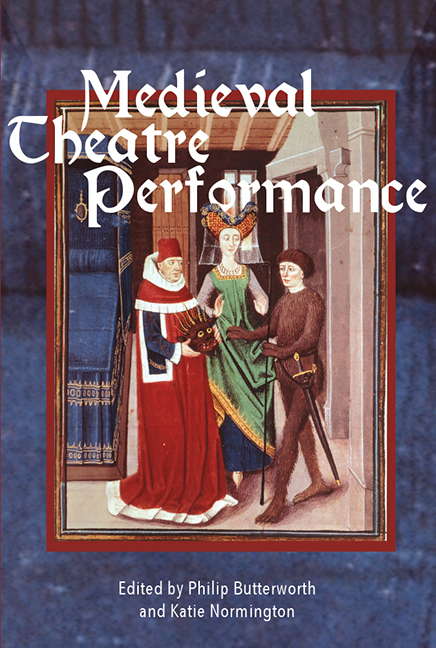Book contents
- Frontmatter
- Dedication
- Contents
- List of Illustrations
- Contributors
- Abbreviations of Principal Sources Cited
- Introduction
- Synopses
- 1 From Archive to Repertoire: The Disguising at Hertford and Performing Practices
- 2 Walk, Talk, Sit, Quit? On What Happens in Netherlandish Rhetoricians’ Plays
- 3 Performing Intrusions: Interaction and Interaxionality in Medieval English Theatre
- 4 Player Transformation: The Role of Clothing and Disguise
- 5 Pavilioned in Splendour: Performing Heaven in Fifteenth-Century Florence
- 6 Living Pictures: Drama without Text, Drama without Action
- 7 Performer-Audience Relationships in Fifteenth- and Sixteenth-century Danced Spectacles
- 8 Decadance in the Late Middle Ages: The Case of Choreomania
- 9 Writing, Telling and Showing Horsemanship in Rhetoricians’ Farce
- 10 Inanimate Performers: The Animation and Interpretive Versatility of the Palmesel
- 11 ‘lyke unto a lyvelye thyng’: The Boxley Rood of Grace and Medieval Performance
- 12 The Mechanycalle ‘Ymage off Seynt Iorge’ at St Botolph's, Billingsgate, 1474
- Bibliography
- Index
11 - ‘lyke unto a lyvelye thyng’: The Boxley Rood of Grace and Medieval Performance
Published online by Cambridge University Press: 21 August 2018
- Frontmatter
- Dedication
- Contents
- List of Illustrations
- Contributors
- Abbreviations of Principal Sources Cited
- Introduction
- Synopses
- 1 From Archive to Repertoire: The Disguising at Hertford and Performing Practices
- 2 Walk, Talk, Sit, Quit? On What Happens in Netherlandish Rhetoricians’ Plays
- 3 Performing Intrusions: Interaction and Interaxionality in Medieval English Theatre
- 4 Player Transformation: The Role of Clothing and Disguise
- 5 Pavilioned in Splendour: Performing Heaven in Fifteenth-Century Florence
- 6 Living Pictures: Drama without Text, Drama without Action
- 7 Performer-Audience Relationships in Fifteenth- and Sixteenth-century Danced Spectacles
- 8 Decadance in the Late Middle Ages: The Case of Choreomania
- 9 Writing, Telling and Showing Horsemanship in Rhetoricians’ Farce
- 10 Inanimate Performers: The Animation and Interpretive Versatility of the Palmesel
- 11 ‘lyke unto a lyvelye thyng’: The Boxley Rood of Grace and Medieval Performance
- 12 The Mechanycalle ‘Ymage off Seynt Iorge’ at St Botolph's, Billingsgate, 1474
- Bibliography
- Index
Summary
In this chapter I would like to consider how medieval audiences are likely to have responded to and read animated sculptures as they performed the character of Christ in liturgical, paraliturgical, other ritual, and/or theatrical contexts. In particular, I would like to consider the Boxley Rood of Grace as both performer and performance. The Rood was an English mechanical1 crucifix removed from Boxley Abbey near Maidstone in Kent during the Dissolution of the monasteries; it was decried as a Catholic mammon and publicly destroyed. I take inspiration from Richard Schechner, who, in Between Theater and Anthropology, offers readers an analogous performance for consideration, inviting us to ‘Think what an event it would be if the Pope played Christ at Oberammergau.’
I will argue that performance of the Christ-figure in the Boxley Rood of Grace offers insight into the following conditions: 1. the perceived relation of medieval performer to performance; 2. an important alternative mechanism allowing and effecting the transmission through time of performance practice, which differs from the transmission of dramatic text; 3. the relationship of what I describe as individual ‘innovation’ within local performance to more widely meaningful medieval traditions and general praxis. Finally, I will consider the history of the Boxley Rood of Grace as both ‘transportation’ and ‘transformation’ performances (as articulated by Schechner) and its status and skill as centrally important readings of these two kinds of ‘events’.
Schechner does not develop his idea of a Christ-playing pope at any length. Instead, he focuses on defining and contrasting two types of performance which help to illuminate the Rood of Boxley's particular representation of the character of Christ over its long history. Schechner compares what he calls ‘transportation performances’, i.e. those that leave their actors unchanged over the course of a production with ‘transformation performances’ which effect change in or re-define their actors, such as initiation rites that transform boys into men. Lead performers in transformation performances take focus primarily because of their identity or ‘status’. Boys participating in initiation rites, for example, are of central importance because of their marginal and changing status, and likely do not sing or dance as well as the older men guiding these rites, for whom the performance is transportive and not transformative. In contrast, performers in transportation performances most often create focus because of their skill, although this is not always the case.
- Type
- Chapter
- Information
- Medieval Theatre PerformanceActors, Dancers, Automata and their Audiences, pp. 197 - 214Publisher: Boydell & BrewerPrint publication year: 2017

